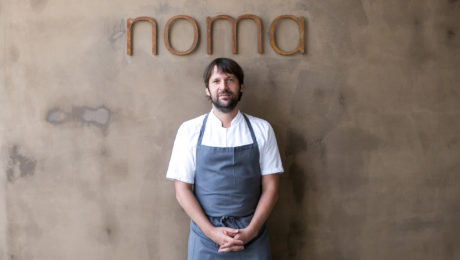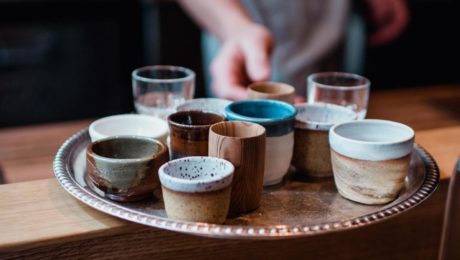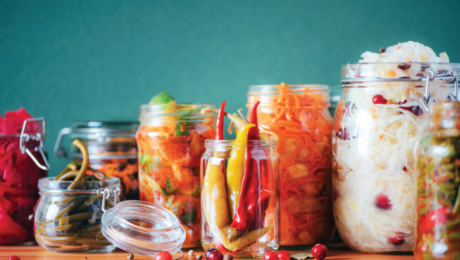Native American Brewery with Traditional Flavors
Bow & Arrow Brewing in New Mexico is part of two small but growing groups in the U.S. — it is both female- and Native American-owned.
Bow & Arrow locally sources their traditional Native American ingredients (blue corn, Navajo tea, three-leaf sumac) for their seasonal sour beers. The hops they use — subspecies neomexicanus — were used for their antiviral properties by the Navajo people in the Southwest,who put them in teas and salves. The brewery owners — Missy Begay and Shyla Sheppard — forage for hops in the mountains near Albuquerque. They also give their spent brewing grains to a local Native American family for use as feed for their livestock.
Begay, pictured left (who is Diné [Navajo]) and Sheppard, pictured right (a member of the Three Affiliated Tribes [Mandan, Hidatsa, and Arikara]) met at Stanford University in 2000. They took different career paths, but both fell in love with craft beer and homebrewing. They opened Bow & Arrow Brewing Co. in 2016.
“There is a sweetness to the land here, and all of this is sacred. We hope, as Native American women brewery owners, that people understand the story we have to tell,” Begay says.
Read more (Outside)
- Published in Business, Food & Flavor
Reviving Sake with SoCal Style
James Jin of Nova Brewing Co. doesn’t want to create a Japanese-style sake — he’s working to create a Southern Californian sake.
Jin uses Calrose rice grown near Sacramento, imports koji and yeast from Japan and designs his own brewing equipment. The flavor of his modern sake is thanks to a secret blend he uses to make the koji rice (the base for the sake), utilizing both yellow and black koji spores, as well as yeast from the Brewing Society of Japan. The flavor — more wine-like, fruitier, higher in acidity and easily paired with food — “it’s a lot more appealing to the younger generation.”
“I respect the history of sake brewing, but it’s a dying art in Japan,” Jin says, adding, “Sales of sake [are] constantly going down [there]. I’m one of the few brewers in America trying to bring the dying art back to life.”
“I’m not a Japanese brewer. I’m an American brewer. I purposefully do things they wouldn’t do in Japan.”
Nova Brewing produces four sakes and 10 craft beers at their facility in Covina, California. They are the only craft sake brewery and tasting room in Los Angeles County — and the only sake and beer hybrid producer in California.
Read more (Los Angeles Times)
- Published in Business, Food & Flavor
U.S. Celebrities Infiltrate Mexico’s Tequila Industry
Tequila sales last year were 60 million gallons, 800% higher than two decades ago. This agave-based spirit has become so popular that distillers are “selling it at the price of gold.” What caused the boom? Celebrity endorsements.
From George Clooney to Arnold Schwarzenegger, LeBron James to Nick Jonas and Dwayne “The Rock” Johnson to Kendall Jenner, celebrities have made billions off their tequila brands.
A Los Angeles Times article highlights the pros (a booming local economy in Mexico, tequila being introduced to more people) and the cons (environmental concerns, agave plants harvested too young, diverse crop fields and forests turned into monocultures of agave, foreigners taking over a traditional drink) of this growth. The article continues:
“Pre-Hispanic Indigenous groups in Mexico had been fermenting agave into a viscous alcoholic drink known as pulque for centuries when Spanish conquistadors arrived in the 16th century and first distilled tequila. It has since evolved into an $10.8-billion-a-year industry.”
Read more (Los Angeles Times)
- Published in Business
Beyond Kombucha: Pu’erh, Jun and Dark Tea
Tea consumption globally is increasing. But consumers don’t want a cheap, poor quality tea bag. They’re buying premium teas — and increasingly, dark, fermented teas.
“What’s trending right now seems to be authentic tea, tea that has great flavor, more closely married to the terroir. People are beginning to understand that it’s just fine to have tea. You don’t have to have coloring in it, you don’t have to have a lot of bits and pieces of fruit and flowers, there’s a genuine benefit to just understanding the terroir and keeping it simple,” says Dan Bolton, the founder, editor and publisher of Tea Journey. Bolton and two tea experts discussed two lesser-known fermented tea varieties in the TFA webinar Beyond Kombucha: Pu’erh, Jun and Dark Tea. “Tea just isn’t as good as it could be, without fermentation.”
A new study on tea demonstrates how important fermentation is to tea quality, Bolton says. Researchers from the Anhui Agricultural University in China recently studied the effect of surface microbiomes on the quality of black tea. The results found microbial fermentation in non-sterilized control tea samples produced complex compounds and more flavorful teas than with sterilized tea leaves. The results were published in the Journal of Agricultural and Food Chemistry.
“It’s a remarkable finding because, certainly for the last century or so, there’s been a lot of discussion about whether fermentation plays a role in the production and processing of tea,” Bolton says. The study proves “black tea is actually a result of both fermentation and oxidation.”
Pu’erh Tea
Jeff Fuchs — author, Himalayan explorer and co-founder of Jalam Teas — shared details of pu’erh tea. Pu’erh is a tea style from a strain of camellia leaf cultivated and produced in the Yunnan province. Fuchs spent over a decade living in there and is the only Westerner to have traveled the Tea Horse Road through Sichuan, Yunnan and Tibet.
“Pu’erh is a tea that certainly I think it’s been deliberately mystified to some degree,” Fuchs says. “It’s interesting that you have this very simple, raw material green tea that is now arguably one of the great boutique commodities.”
Fuchs stresses consumers need to research tea sourcing. Where is the tea coming from? How was it stored? Who stored it? Older tea cakes are being sold for large amounts of money, but can have questionable provenance.
“Young teas I think are making a big assertion in the tea world right now because they represent a closer line to the terroir, a closer line to the origin point,” he says, adding dark teas are becoming more popular in North America. He sees more bartenders experimenting with dark teas, playing with flavor compounds. “I think dark teas will come into the sway more and they’ll remain.”
Jun Tea
Jun is another tea style making waves in the fermented beverage market. It is a type of kombucha, but the base is green tea and honey instead of black tea and sugar. Brendan McGill shared his experience making jun — he is a chef and James Beard nominee; he owns the Hitchcock Restaurant Group in Seattle and the newly-launched Junbug Kombucha.
“Jun is a very special style of kombucha,” McGill says. “It’s shrouded in mystery, where these cultures originated. What we do know is how they’ve been developed and manipulated in fairly recent history. One of the joys I’ve had with this is just being extremely creative because i found that while the fermentation isn’t necessarily a delicate process, it has allowed us to modify and use a lot of different inputs that it’s actually a pretty robust fermentation process.”
McGill began making kombucha over a decade ago, as a replacement for beer and wine. He liked jun for its similar flavor to alcohol, the additional bioactive compounds that create a more nutritious drink and it’s made with honey instead of added sugar.
Junbug Kombucha uses filtered water, organic green tea, wild honey and, of course, a SCOBY. In the secondary fermentation, fresh herbs, berries and even mushrooms are added. Junbug flavors include Chaga Root Beer, Chili Raspberry and Maui Mana.
- Published in Business, Food & Flavor
Managing Fermented Food Microbes to Control Quality
Fermented foods are produced through controlled microbial growth — but how do industry professionals manage those complex microorganisms? Three panelists, each with experience in a different field and at a different scale — restaurant chef, artisanal cheesemaker and commercial food producer — shared their insights during a TFA webinar, Managing Fermented Food Microbes to Control Quality.
“Producers of fermented foods rely on microbial communities or what we often call microbiomes, these collections of bacteria yeasts and sometimes even molds to make these delicious products that we all enjoy,” says Ben Wolfe, PhD, associate professor at Tufts University, who moderator the webinar along with Maria Marco, PhD, professor at University of California, Davis (both are TFA Advisory Board members).
Wolfe continued: “Fermenters use these microbial communities every day right, they’re working with them in crocks of kimchi and sauerkraut, they’re working with them in a vat of milk as it’s gone from milk to cheese, but yet most of these microbial communities are invisible. We’re relying on these communities that we rarely can actually see or know in great detail, and so it’s this really interesting challenge of how do you manage these invisible microbial communities to consistently make delicious fermented foods.”
Three panelists joined Wolfe and Marco: Cortney Burns (chef, author and current consultant at Blue Hill at Stone Barns in New York, a farmstead restaurant), Mateo Kehler (founder and cheesemaker at Jasper Hill in Vermont, a dairy farm and creamery) and Olivia Slaugh (quality assurance manager at wildbrine | wildcreamery in California, producers of fermented vegetables and plant-based dairy).
Fermentation mishaps are not the same for producers because “each kitchen is different, each processing facility, each packaging facility, you really have to tune in to what is happening and understand the nuance within a site,” Marco notes. “Informed trial and error” is important.
The three agreed that part of the joy of working in the culinary world is creating, and mistakes are part of that process.
“We have learned a lot over the years and never by doing anything right, we’ve learned everything we know by making mistakes,” says Kehler.
One season at Jasper Hill, aspergillus molds colonized on the rinds of hard cheeses, spoiling them. The cheesemakers discovered that there had been a problem early on as the rind developed. They corrected this issue by washing the cheese more aggressively and putting it immediately into the cellar.
“For the record, I’ve had so many things go wrong,” Burns says. A koji that failed because a heating sensor moved, ferments that turned soft because the air conditioning shut off or a water kefir that became too thick when the ferment time was off. “[Microbes are] alive, so it’s a constant conversation, it’s a relationship really that we’re having with each and every one on a different level, and some of these relationships fall to the wayside or we forget about them or they don’t get the attention they need.”
Burns continues: “All these little safeguards need to be put in place in order for us to have continual success with what we’re doing, but we always learn from it. We move the sensor, we drop the temperature, we leave things for a little bit longer. That’s how we end up manipulating them, it’s just creating an environment that we know they’re going to thrive in.”
Slaugh distinguishes between what she calls “intended microbiology” — the microbes that will benefit the food you’re creating — and “unintended microbiology” — packaging defects, spoilage organisms or a contamination event.
Slaugh says one of the benefits of working with ferments at a large scale at wildbrine is the cost of routine microbiological analysis is lower. But a mistake is stressful. She recounted a time when thousands of pounds of food needed to be thrown out because of a contaminant in packaging from an ice supplier.
“Despite the fact that the manufacturer was sending us a food-grade or in some cases a medical-grade ingredient, the container does not have the same level of sanitation, so you can’t really take these things for granted,” Slaugh says.
Her recommendations include supplier oversight, a quality assurance person that can track defects and sample the product throughout fermentation and a detailed process flow diagram. That document, Slaugh advises, should go far beyond what producers use to comply with government food regulations. It should include minutiae like what scissors are used to cut open ingredient bags and the process for employees to change their gloves.
“I think this is just an incredible time to be in fermented foods,” Kehler adds. “There’s this moment now where you have the arrival of technology. The way I described being a cheesemaker when I started making cheese almost 20 years ago was it was like being a god, except you’re blind and dumb. You’re unleashing these universes of life and then wiping them out and you couldn’t see them, you could see the impacts of your actions, but you may or may not have control. What’s happened since we started making cheese is now the technology has enabled us to actually see what’s happening. I think it’s this groundbreaking moment, we have the acceleration of knowledge. We’re living in this moment where we can start to understand the things that previously could only be intuited.”
- Published in Food & Flavor, Science
Redzepi: We Need Restaurants to “Feel Alive”
Restaurants have been under tremendous economic pressure, suffering from business losses during the Covid-19 pandemic. And there’s now a staffing shortage, as long hours and low pay have driven many away from the industry.
Bloomberg columnist Bobby Ghosh explored how restaurant dining may change in an Instagram live interview with Rene Redzepi, owner and co-owner of Noma, Copenhagen’s two-Michelin star restaurant world-renowned for its experimental fermentation lab. Pandemic restrictions shut down Noma twice, forcing Redzepi to create additional revenue streams outside the traditional dining room.
In the summer of 2020, Noma opened an outdoor, walk-in burger and wine bar. Earlier this month, they announced Noma Projects, a direct-to-consumer line that will initially sell garums.
Below are highlights from Ghosh’s interview with Redzepi.
Ghosh: What did you learn about how people were feeling about returning to restaurants?
Redzepi: Restaurants, you don’t need them to stay alive but you need them to feel alive. That was very, very clear, that people were ready to go out. You know they say it’s the catch-up effect, and that definitely happened here in Copenhagen. People were everywhere, they were in piles to get a bite to sit down, have a glass of wine and meet other people.
Ghosh: When you began to think about reopening the proper dining space and planning your menu for the reopening, did you have any particular thoughts or concerns about whether people’s habits in restaurant dining might have changed in the course of the year that they were all locked up?
Redzepi: Yeah, so we went through the first lockdown, opened up, we were open for about five months and then it all came back and we had to close (again during the second lockdown). On the second lockdown, we were shut for six months and, in that time, we were very worried about everything, I mean we still are, but I guess we’re a little less worried now than before because we’re finally open again. We did think “Would people even sit for hours in a restaurant? What is it that everyone wants?” Besides that, people in Denmark, they started really cooking at home again. Takeaway offerings had become quite common, even from some of the best restaurants, something that would be considered completely impossible five years ago. If you had takeaway as a fine dining establishment, you sort of sold out in a way and that was starting to happen.
But I decided with myself, and that was a personal decision, is that in my life I need this creativity, I need to have guests, I need to work on a menu on a daily basis, so during the lockdown I went to work every day in the kitchen as if we were going to open the following day. We actually made two full menus and one of them will never be served because we ended up being closed throughout it. And then we said “OK, let’s just open up and see what happens, will people still want to come out?” and we opened up our reservations knowing that we would cater only to 100% local crowd and it’s gone really well, really really well.
Ghosh: The thrill of being in a nice restaurant and being able to talk to people and enjoy a meal is incomparable um and I do appreciate the value of fun after the year and a half that we’ve all had. Can you give us an example of a dish that you have in your menu now that reflects this attitude of fun, the surprise.
Redzepi: Swedish saffron believe it or not, it’s really, really strong and tastes amazing. We make this fudge with it and we found out that you can actually use the sort of the cutting of walnut as a wig for candles because the oil content in the walnut makes it flammable. And so we basically shaped or molded this little toffee into a candle. It sounds complicated but it’s quite easy to do when it’s hot and then we put this walnut light into it and it comes to the table when they’re drinking coffee and people think it’s you know for coziness and then as it burns out people are then instructed to eat it that’s a that’s a moment where that’s fun you know it’s creativity, it’s delicious it surprises people and it just really makes it makes a difference to people you can feel that they’ve been needing something like that.
Ghosh: What have you learned that you didn’t already know about restaurant economics over the past year that now factors in your thinking about what Noma is and what Noma needs to be in the future.
Redzepi: Oh man, you’re hitting something that we’ve been talking about for the past two years because, particularly in the last year-and-a-half, restaurant economics, they’re terrible. We’ve had 18 years of operation and we’ve had an average profit of 3%. It’s just enough to keep us running and keep painting the house, so during this pandemic we did think to ourselves “Are we going to continue like this for another 18 years, where we don’t have any money to change anything, even if we want it?” You know we’re going to have to find different ways of operating so that we can have a different economics in it. We have to figure out a way if we want to be here for another 18 years because you know it won’t continue like this. So we have definitely thought of many many things and recently we launched this thing that we call Noma Projects. Noma Projects is a sort of a platform to launch a myriad of things, it’s a for-profit company, but we only want to attack projects that also connect to some sort of a worldly issue, and the first project one is is a vegan and a vegetarian garum sauce that you use as a flavoring to add umami to your vegetarian and vegan cooking. It’s a way to help people eat more vegetarian so that’s project one, that’s something that we worked on almost almost since the first lockdown that happened to us we were like we need to step into this.
Ghosh: About six months ago, I did a piece about restaurant economics and the pandemic. I talked to your friend David Chang of Momofuku. We’re saying that we have to figure out more ways to find revenues outside of the dining room. You know, can we get 50% of the revenue from outside of the dining room where the margins are larger to sustain, to underwrite the amazing creativity that goes on in your kitchens? Is that possible? Have consumer tastes or consumer behaviors now changed in a way that will allow that kind of thing?
Redzepi: I think what happened during the pandemic is that it’s been considered more OK for restaurants of say Momofuku caliber or Noma to actually think of ways to put better economics into the system. That has opened a new door and for us, we’re grabbing that opportunity, we need to, definitely. Our industry needs to, in general. It’s an industry that’s under copious amounts of pressure, we deal with poor profit margins, low incomes, people are overworked, they’re underpaid, there’s bad management and a lot of it is a result of there’s simply no money in the industry, people can’t afford to do maneuver any new way they want, and we don’t have any business training either. It’s very interesting what’s going on. I think a lot of creativity is going to come out of restaurants in the next couple of years.
Ghosh: Now in addition to being a chef, you’re a thinker in your line of work. Through MAD Academy, which used to be anyway your annual gathering of of great chefs from around the world, you’ve spent a lot of time thinking about your industry and the future of your industry. I imagine that during the course of the past year, year-and-a-half you’ve had many conversations with the kinds of people who would previously have come to that conference. What are some of the common themes, the common challenges for fine dining establishments?
Redzepi: I think in food in general, the most common problem, and I think it’s going to continue for a while, is that there’s a gigantic staff shortage right now. I think in the pandemic, a lot of people have had an opportunity to rethink their life and say “OK, am I in this industry for the next 20 years or is this a moment for me now to start studying or become a farmer or something else.” That is really the biggest issue that we have right now, there’s no question in my mind. This is something that at MAD we’ve been discussing for almost a decade. If we’re not able to help transform (and this includes myself by the way I’ve spoken about this many times) this gigantic lack of leadership that we face as an industry where we have a poor ability to actually just manage ourselves, manage our restaurants and be supportive of people, that will be the first step that needs to happen which is slowly happening. But then providing better pay and better work hours, that are related to economics. I see our industry being far from that, unless we figure out a way to either charge more that there’s more value towards foods and people that work in the industry or we find other revenue streams. Those are the big, big questions that we are dealing with at MAD. At Noma, I deal with this as a employer myself, how to actually be an inspiration, but how to also provide for staff that are having children, and how can we have everyone stay here for 40 years in this industry? That’s really hard questions.
- Published in Business
Pairing Sake with Food
Does sake go well with Western dishes? Josh Dorcak, chef of Japanese restaurant Mäs, tells Forbes why he thinks sake is an excellent pairing with all food types, maybe even more so than wine.
“Sake pairs with everything,” Dorcak says. “With wine often it seems like there are these rules that one must follow while sake often fits the bill for creative pairings.”
Read more (Forbes)
- Published in Food & Flavor
The Flavors of Fermentation
From pickling foraged plants to experimenting with koji to vacuum-sealing tempeh, more chefs are experimenting with fermentation. Insights “for menu developers seeking unique concepts and ingredients” were shared during a session at the Research Chefs Association’s RCA+ virtual conference.
Sandor Katz, noted author and educator, discussed how research kitchens can increase their fermentation activities, from creating interesting flavors to expanding food preservation.
“[Fermentation] can elevate the plainest of foods into flavor sensations,” Katz said. “Its uses in culinary traditions around the world are incredibly diverse, and yet visionary chefs are experimenting with exciting new applications of fermentation.”
Read more (Food Business News)
- Published in Food & Flavor
Bubbling Over: Why Kimchi Is the Fastest-Growing Fermented Veggie in America
Sales are soaring. Although kimchi only makes up 7% of the pickles and fermented vegetables category, its sales are increasing at an explosive 90% rate, according to SPINS.
We asked three kimchi experts their thoughts on the uptick in sales: Minnie Luong, founder and CHI-EO of Chi Kitchen, JinJoo Lee, chef and Korean Food Blogger at KimchiMari and Kheedim Oh, founder and Chief Minister of Kimchi for Mama O’s (and member of TFA’s Advisory Board).
We asked them: Why do you think kimchi sales are increasing so rapidly?
Minnie Luong: Originating in Korea around 4,000 years ago, kimchi is an iconic food symbolic of hope, trust, and survival that is the perfect food for our current times. One of the world’s most special foods, it elicits delight, storytelling and sharing. In fact, UNESCO has designated kimjang — the traditional way of making and sharing kimchi — a designated intangible cultural heritage of humanity.
Low in calories, high in fiber and big on flavor that’s great for your digestion and gut health, kimchi is uniquely poised to cross over from being a specialty food to a must-have pantry staple for health and wellness enthusiasts, home cooks and those seeking out a satisfying flavor adventure. Its spicy, tangy, umami flavor is convenient and easy to use across a wide range of dishes along with a long shelf life when refrigerated. Just open a jar and it’s ready to go! While kimchi is often seen as a condiment, it should really be considered a vegetable, but one that packs a delicious, probiotic punch. Let’s face it, we could all use more veggies and flavor in our lives!
JinJoo Lee: I think the sales of kimchi are increasing because more and more people are aware of the health benefits of kimchi (loaded with probiotics like many fermented foods) and also are being introduced to the wonderful flavors of it now through many restaurant foods and magazine recipes.
More restaurants have started to use kimchi in their menu because I think chefs have realized kimchi works great in non-Korean dishes such as on hamburgers, pasta, cheese quesadillas and even with Brussels sprouts!
Kimchi has a very deep and complex flavor with an amazing zing that fermented foods have but it also is a perfect balance of sour, spicy, salty, umami and slightly sweet that works well with so many different foods, especially meats and seafood.
Most Americans may know only the spicy napa cabbage kimchi (Baechu Kimchi) but did you know there are over 100 different kimchis? kimchi can be made using all sorts of different vegetables such as cucumber, eggplant, radish, mustard greens, green onions, chives and more.
If made and stored properly, kimchi can last for weeks, months and years and it can be enjoyed throughout all the different stages of fermentation – from the very beginning as fresh tasting to fully ripe to overly ripe and sour then even when it’s aged for years! So kimchi is the perfect fermented food that’s tasty, healthy, versatile and even long-lasting.
Kheedim Oh: With everyone in the world simultaneously experiencing sensations of uncertainty mixed with mortal fears of peer contact, people are drawn to the near mythic powers of kimchi. One of the top 5 healthiest foods in the world (according to Health Magazine). A true superfood. People are attracted to the promises of probiotics. The comfort of supporting their immune systems with each bite. The flavor of fermentation. The addictive nature of how eating good kimchi makes you feel.
The word kimchi has reached a tipping point where it’s no longer just the stinky rotting cabbage from Korea (or wherever) to the acidic/tart vegetable dish that “I had as part of a dish at the insert [trendy fusion restaurant] that I went to and I heard it’s really good for you.” It’s losing its Korean-ness and quickly being subsumed into White American food culture the way that kombucha has already completely become. There are a lot of “kimchis” that are only kimchi through very loose interpretations or are just not real kimchi by any definition, only by name. The culprits being many of the before-mentioned fusion restaurants.
On the other hand, there is the whole DIY home fermentation movement that has been growing year over year. Educating themselves on how to achieve food sovereignty, they tend to be a more culturally sensitive crowd. Regardless of the hype surrounding the word, we hope that kimchi can maintain its popularity in America while maintaining its unique UNESCO World Heritage recognized cultural identity as a Korean food.
- Published in Business, Food & Flavor
The Many Sides of Kefir
When Julie Smolyansky began working at her family’s Lifeway Foods business, her father advised her: “Don’t talk about the bacteria. People in America freak out about the bacteria on their food.” So when Lifeway became the first company in the U.S. to put “probiotic” on a label in 2003, it wasn’t a big surprise when customers began calling, asking for the company’s non-probiotic version of kefir.
Americans have come a long way. Consumers today search for the “live, cultured” label on fermented dairy, and gut health is a critical component of the modern diet. Smolyansky and Raquel Guajardo, author/educator, shared their thoughts on kefir during the TFA webinar The Many Sides of Kefir.
“Fermented foods were not part of the American diet, and the way that kefir and fermented foods in general were used in other parts of the world from Asian to Eastern Europe to even India and Mexico, these cultures all have fermented foods as one of their pillars as their foods sources and their health and wellness cultures,” Smolyansky says. “It wasn’t until immigration from all these other countries that we started talking about kimchi or kefir or lassi or you name your cultured kind of special food.”
In the U.S., the average person consumes 9-10 cups of fermented dairy a year. Contrast that statistic with Europe, where the average consumption is 28 cups a month.
“When you’re born consuming it and you’ve developed that taste palette, then it’s very easy to play in the space and have a diet that’s very rich in probiotics and kefir and all sorts of other fermented foods,” Smolyansky says, adding that the situation is changing in the U.S. Now, “people are hungry for it, they want it, once they learn about it, once they taste it, they fall in love with it, they’re hooked.”
Lifeway’s kefir’s sales have soared. The company was valued at $12 million when Smolyansky took over in 2002 — now it’s valued into the hundreds of millions. And even more customers have found kefir during the COVID-19 pandemic, as they adopt healthier lifestyles.
Guajardo has seen her online classes increase during COVID. The Mexico-based educator co-authored the book “Kombucha, Kefir, and Beyond” with Alex Lewin, TFA advisory board member, who moderated the webinar.
“People say ‘You’re crazy, why do you teach what to do at home what you can buy in the supermarket?’ But my business has been growing that way,” she says, adding that health benefits are the main selling point for her classes. “Why would people buy sauerkraut or kefir if you’re not explaining the benefits?”
Dairy Kefir vs. Water Kefir
Guajardo, who makes both dairy kefir and water kefir (also known as tibicos) stresses that the grains used to make each are “totally different.” Kefir grains are living bacteria and yeast microorganisms clumped together with milk proteins and sugars. They are gelatinous and white, almost like cottage cheese. Water kefir grains are also made from living bacteria and yeast microorganisms, but they’re clumped together with sugar and have a translucent, crystal-like appearance.
“Water kefir” is not the appropriate term, Guajardo and Smolyansky agree, instead calling it by its traditional Mexican name, tibicos. And they feel that using kefir or tibicos grains in coconut or almond milk and calling it kefir is also inappropriate. Smolyansky favors using a description like cultured coconut milk or beverage, but not kefir.
The National Dairy Council and Codex Alimentarius, the international food code, both state kefir is a fermented dairy product made from the milk of a lactating mammal. Smolyansky points to the many peer-reviewed studies on kefir, verifying it is full of probiotics and nutrients. Water kefir and non-dairy kefir have not been studied, and can’t guarantee the same health benefits.
“Just by throwing the name onto anything and just bastardizing the definition, we completely dilute any of the research that’s ever been done [on kefir], it would dilute the history, the folklore. So we are very passionate about protecting the name,” Smolyansky says. “My ancestors made sure that kefir survived for 2,000 years, and it’s critical that we don’t dilute it now that it’s having a moment, now that it’s popular.”
Smolyansky’s family emigrated to the United States from the then Soviet Union in the late ‘70s. Her father, Michael, began Lifeway Foods in Chicago in 1986.
“We have to respect the standards and what these definitions mean or it will be the Wild West and people won’t know what they’re buying,” she adds. She shares the labelling of ice cream as an example — ice cream is considered dairy while non-dairy products have other names, like sorbet, gelato or non-dairy frozen dessert.
Can Kefir Grow Like Yogurt?
Yogurt has paved the way for kefir to expand its consumer base in the U.S. Both are fermented dairy products with tangy tastes. But for kefir to achieve widespread, mainstream adoption like yogurt, significant education is needed. Thousands of peer-reviewed studies prove kefir contains a higher concentration of probiotics than yogurt — and a wider range of beneficial bacteria. For kefir to grow, this message needs to reach consumers.
“It’s a different set of microbes,” Lewin says. “Kefir is fermented with yeast and yogurt isn’t. Kefir has a larger family of microbes.”
Smolyansky is passionate that kefir cannot be compared to the products of the major. yogurt companies.
“The yogurt produced in the United States is so over-produced and so over-pasteurized that there’s practically nothing living in it after it’s been processed,” she says. “It’s one of the biggest problems with yogurt in the U.S.”
Lifeway regularly sends their products to be tested for probiotics, measuring Colony Forming Units (CFUs), the active microorganisms in a food product. Smolyansky says eating probiotics is critical in a germ-phobic, antibody-heavy society, where we’re over-sanitizing due to the coronavirus pandemic.
“If our bodies aren’t fighting an outside kind of pathogen, it starts to fight itself,” she says. “One of the ways to counteract this disruption in our microflora is by the use and the introduction of consistently replenishing microflora including diversity of bacteria, a variety of food sources that offer bacteria, the diversity and kind [of bacteria] is always the king. It makes for great food environments in the gut.”
- Published in Business, Food & Flavor










